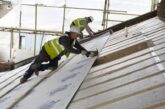
Marcus Jefford, Managing Director of estimating service Build Aviator, which works in partnership with Jewson, outlines what you need to know
This month marks the end of the grace period for the building regulations changes that came into force in June 2022, meaning that the rules apply to any projects that haven’t yet started and to all new work moving forward. But in recent conversations with our customers, we know many of you are unclear on what this means and are concerned about the cost implications for your own clients. In this article, we will share the key details for the Part L changes and how to navigate the new rules.
Understanding the context
Firstly, it is important to note that the changes are largely positive and will help to improve the UK’s housing stock, which ultimately benefits homeowners. They will lead to higher standards and help to make more energy efficient homes, which is vital during the current climate of rising energy costs. If you are having any conversations with your clients about the changes, it is worth communicating this and explaining the wider context. Sustainability is at the heart of the matter, and the new Part F, Part L, Part O and Part S building regulations are seen as a stepping stone to bigger changes coming in 2025, when the Future Homes Standard will be introduced. Unfortunately, many of these positives are currently being lost due to a lack of communication, with builders and tradespeople often stuck in the middle.
When it comes to the new rules, whether you are working on a new build or extending an existing property, you must now meet the new standards when submitting the project to Building Control. Part L concentrates on energy efficiency and all new homes will now be assessed under a new Standard Assessment Procedure (SAP) calculation, known as SAP10. The SAP calculation must be performed at the design stage and again upon completion, measuring the Dwelling Emission Rate (DER) and the Target Emission Rate (TER).
Products for Part L
There are a whole host of products available to help you comply with Part L. Jewson’s Making Better Homes range is designed with this in mind, making it easy to find all compliant solutions in one place. Solar panels and heat pumps should be considered for any new homes and extensions, as they can help you to pass SAP10 measures. Part L favours renewable and low-carbon energy sources over traditional alternatives, and the regulations state that any new-build properties with gas central heating or an electric boiler must have solar PV by law. If not, you must install a ground or air source heating system to meet the SAP10 requirements.
Heat recovery systems are also included in the range, as Part L recommends that they are used in any new-build projects. The systems can convert heat that is lost down the drain into heat for new water and can be retrofitted into existing bathrooms or installed into new ones. There is a real opportunity for plumbers and heating engineers to upskill and begin specialising in these kinds of products and services, with Part L providing a nudge in the right direction.
Insulation is a key area when it comes to Part L and there are now specific requirements regarding the thickness of insulation in new builds. For cavity walls, below ground level and between ceiling rafters and floors, insulation must now be a minimum of 150mm thick. You will need to use 150mm insulation between rafters in sloping ceilings and 50mm underneath, while in horizontal ceilings you should still use 400mm mineral or glass wool products.
If you are renovating a property and you are replacing more than half of a surface element such as a wall, floor or roof, the new rules apply. Similarly, if you are dry lining an internal surface, replacing an existing layer through stripping down an element, replacing the waterproof membrane on a flat roof or providing new cavity wall insulation, you must follow the new regulations. In any of these cases, you should ensure that floor insulation is at least 100mm thick, horizontal ceiling insulation is at least 300mm thick and that sloping ceiling insulation is at least 150mm thick between rafters and 30mm underneath.
All of the above may mean that costs of a typical project will rise, and therefore need to be passed onto homeowners. It may be particularly useful to explain the wider context of the changes in these instances, particularly due to the hidden nature of insulation, which means your clients may not see any visible changes to account for the potentially higher cost. Present the new ways of working as not only a legal requirement but something that will futureproof their home and ensure they’re minimising their impact of their home on the environment.
![]()
Planning is key
Ensure you allow plenty of time to plan and purchase compliant products, and do not assume that every merchant will have what you need in stock. Products like the 150mm insulation that meets the new regulations are likely to be in high demand, so ensure you are purchasing from a supplier such as Jewson, that has the necessary stock levels to help you complete your project on time and within budget. You could also consider using the Build Aviator estimating tool, which guides you through the products and expertise required to remain compliant and works in collaboration with Jewson to ensure materials are supplied at the right time for the stage of the build.
Speak to everyone involved in your project from the very beginning at the design stage, and partner with people who understand the bigger picture and who are focussed on ensuring the project is compliant. Finally, do not assume that you can repeat a tried and tested approach in the same way that you would have done a year ago. The end of the grace period means that there is a high chance the exact same project would be rejected under the current regulations, so treat each new piece of work independently.
It may well be a period of change that presents challenges to the industry, but if we unite to navigate and fully understand the new landscape, there are opportunities and rewards for all involved. Jewson’s downloadable guide contains further details about the changes and how they might affect you.







